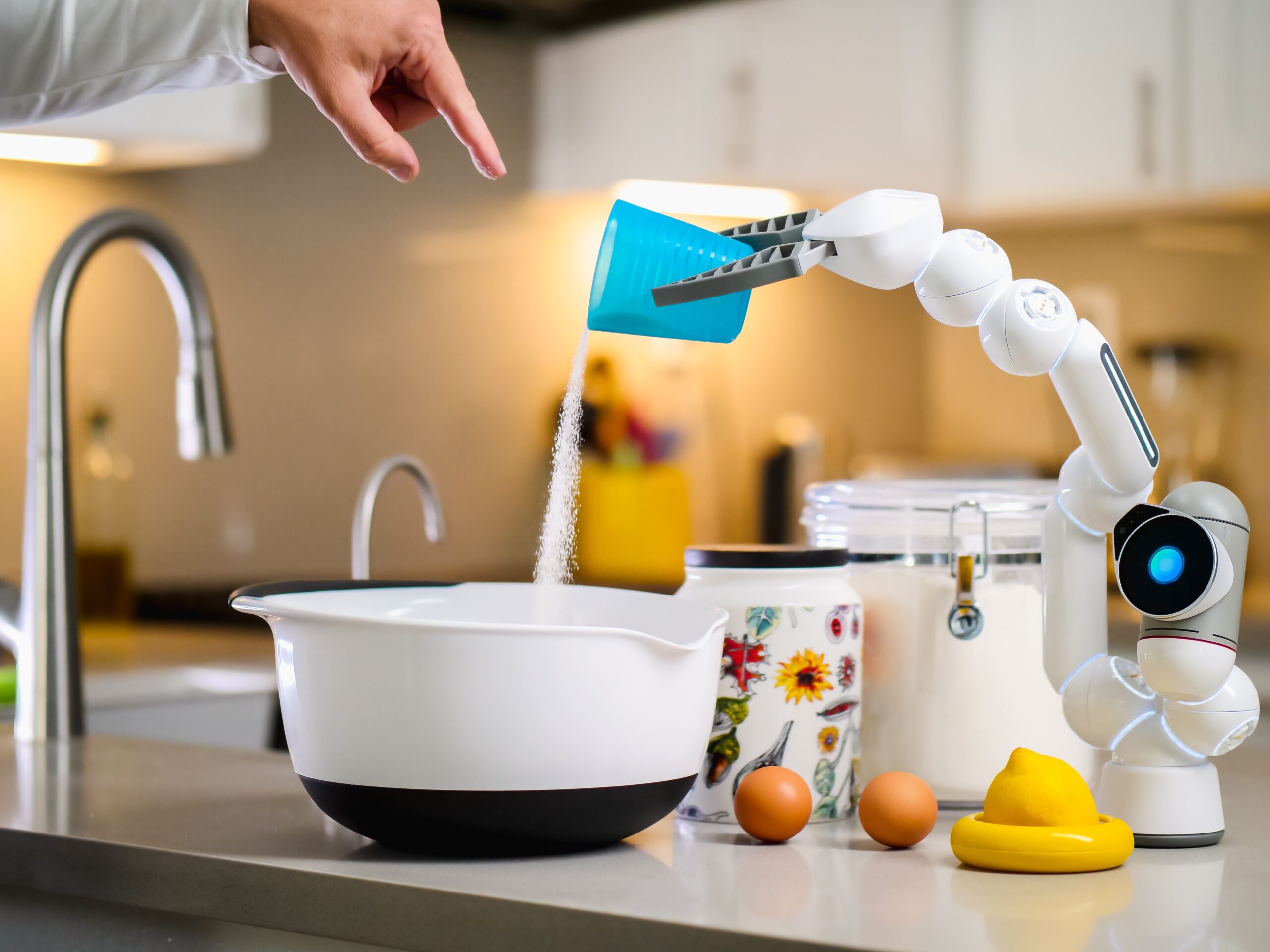If you’ve ever given any thought to what goes on at peak mealtimes behind the doors of a restaurant’s kitchen, be it a regular no-thrills diner or a Michelin-starred luxury establishment, then you’ve probably pictured the high-stress environment: People working in a hurry, hastily grabbing ingredients from shelves or a fridge; rushing baked goodies out of the oven and others making their entry; a cook sprinting across the floor to get to a boiling pot while someone delicately applies final touches to a plate before it gets served… The clock ticks, customers await, ideally to be served warm plates in synchronicity at each table seating… Moreover, each order has its respective recipes, a set of precise tasks and priorities, and strict hierarchies to observe. A small mistake or delay can break the preparation chain. Most restaurant industry experts will tell you that “it all starts with a properly-managed kitchen that is well-equipped, less chaotic, and more streamlined”. The amount of planning and organization that is required for a restaurant kitchen to operate smoothly is often gravely underestimated.
Executive chefs and sous-chefs spend plenty of time and money to manage in-kitchen operations. Much of the effort focuses on the ability to manage orders on the fly in such a way that dishes can be synchronised to be ready simultaneously for all patrons of the same table. Cooks must oversee multiple recipes, which implies different preparation times, and various culinary tools and resources that may overlap. Much like a business project, this requires proper planning with a good oversight of all the available resources and the ongoing operations in the kitchen. Unlike a business project, these kitchen “projects” only last minutes, and they often come with intense repetition, one after the next. The need for automated rapid planning becomes critical across the entire process of the restaurant dining experience: starting from the table booking, to settling the bill. Kitchen Display Systems (KDS) have quickly become common technology not just in fast food chains, but also in luxury restaurants, food boutiques, Michelin Starred Restaurants, and Hotels.
The executive chef of a famous one-starred Michelin restaurant in downtown Milan will be guiding his team through an important digital transformation by the end of 2022 – a time at which they will have a complete up-and-running KDS. His objectives with the KDS are quite simple: reduce the cost of in-kitchen operations and increase the efficiency of preparations – thus ensuring that customers are served on time. This ensures that chefs can focus more on their dishes and less on the planning; Customers are more likely to be satisfied, and thus more likely to return or to speak favourably of the restaurant.
According to the chairman of “The 1894 Lodge” (New Washington, IN), the management has been able to turn around a dire situation in which there had been numerous incidents of forgotten or seriously delayed orders. By implementing a KDS and by replacing the restaurant’s archaic POS, this historic establishment was able to cut customer order-to-served waiting times by more than 50%, thus greatly improving the customer experience. As a result, the restaurant has seen its sales figures double within the first year of implementing the change.
So, what exactly is a Kitchen Display System?
The Kitchen Display System is a large and visible “wallboard” screen, much like what you would find at the heart of a contact centre, visible to all contact centre agents. People often also refer to “Kitchen Automation Systems (KAS)” which is another way to specifically refer to the engine as opposed to the wallboard display. The KDS displays a complete overview of ongoing order preparations, new pending order preparations, and other critical information or metrics, such as Elapsed Waiting Time for each table.
Much like inbound calls are managed in a contact centre (which can be routed to a first available and skilled agent), Kitchen Automation Systems also have a “routing and prioritization” engine at the core. Menu items are configured into the system, considering a detailed breakdown of the preparation steps and their associated time required and resources. Resource planning is overlayed, much like a Workforce Management System would be for contact centre operations. The KDS then adapts its planning in line with shifts for the kitchen staff that is onsite and working (and for new incoming orders).
There are three key benefits to using a KDS:
- Time and cost-saving. Average wait times to be served from the time that an order is placed should be minimised. Each party (people sitting at the same table) should ideally be served in one go (at the same time). With a kitchen automation system, a party’s orders are split into tasks. Each task is assigned to a workstation that is only accountable for one kind of preparation (i.e.: pasta, salads, meat, fish, …). A system of synchronised timers between the workstations manages the triggers for the cooks to start their preparations. This is possible thanks to the implementation of a central database that stores detailed information for each menu item, including recipes, contingency rules, and modification exceptions. The core task management engine then plans the workload and splits the tasks by priority, based on the available kitchen staff at the time of execution. This cuts down the waiting time for each party and thus improves the customer experience.
- Visibility of workload and bottlenecks. The digital system offers the manager a complete overview of the situation both in the kitchen and in the dining room. It is possible to pinpoint any kinks in the chain of events and to address issues on the fly (ex: a backlog on serving plates that are ready to go could benefit from someone to temporarily step in and wait tables). End-of-day reports are also typically generated from the KDS to help analyse the performance of the kitchen staff and to take necessary actions that can help improve the overall process.
- Customer care. We must think about the entire process, starting from the reservation. A registered user that is booking for his or her party has the possibility to inform allergies or dietary preferences, or even to inform of an interest for local food. This information offers a terrific opportunity for restaurant staff (particularly waiters) to improve the customer experience. And for franchised restaurants with integrated systems, this further steps up the possible level of enhanced customer experience.
The restaurant business has always been about the customer experience. Digital transformation has taken this to a whole new level, with KDAs as an innovation hub built around the customer and to facilitate efficient service and personalised experiences. Yet as with all digital transformation, the technology merely facilitates improvement. The face of the restaurant business remains in its people, its leadership and in the processes that bridge the benefits of innovation.
The benefits of kitchen automation systems pave the way for new business models that heavily depend on data science. As ordering systems can now factor in multiple parameters for an accurate estimate of when meals will be served, it was only a matter of time before marketplaces would spring up to solve logistics for home delivery. Home food deliveries have taken the world by storm – especially since the Covid-19 pandemic. “How the world eats is changing dramatically. A little under two decades ago, restaurant-quality meal delivery was still largely limited to foods such as pizza and Chinese. Nowadays, food delivery has become a global market worth more than $150 billion, having more than tripled since 2017. In the United States, the market has more than doubled during the COVID-19 pandemic, following healthy historical growth of 8 percent.” [McKinsey].
The far-reaching disruption generated by KDS systems is remarkable. The ability to accurately estimate order (or meal) readiness paves the way for marketplaces to build a delivery logistics layer on top of the KDS systems. Given the efficiencies gained in the kitchen by KDS systems, restaurants now cater to a whole new clientele, at a much higher volume (consider each order as a virtual table in the restaurant), but also perhaps with much lower margins (food delivery marketplaces are known to take a heavy commission both from the restaurant and from the customer). This shift in business model, in turn, has also paved the way for a new concept of “cloud kitchens.” Cloud kitchens exist for the unique purpose of catering to food marketplaces. They serve “virtual tables” alone, and there is no dining room to host guests. Customers may only place in-app orders from the marketplaces in which these cloud kitchens are hosted.
The contrast in which a KDS may be at the root for new virtual concepts such as “cloud kitchens”, as opposed to the rich and immersive customer experience that it may offer at a brick-and-mortar restaurant demonstrates the magnitude of this disruption. It is safe to say that kitchen automation systems are cementing their way into today and tomorrow’s kitchen.






